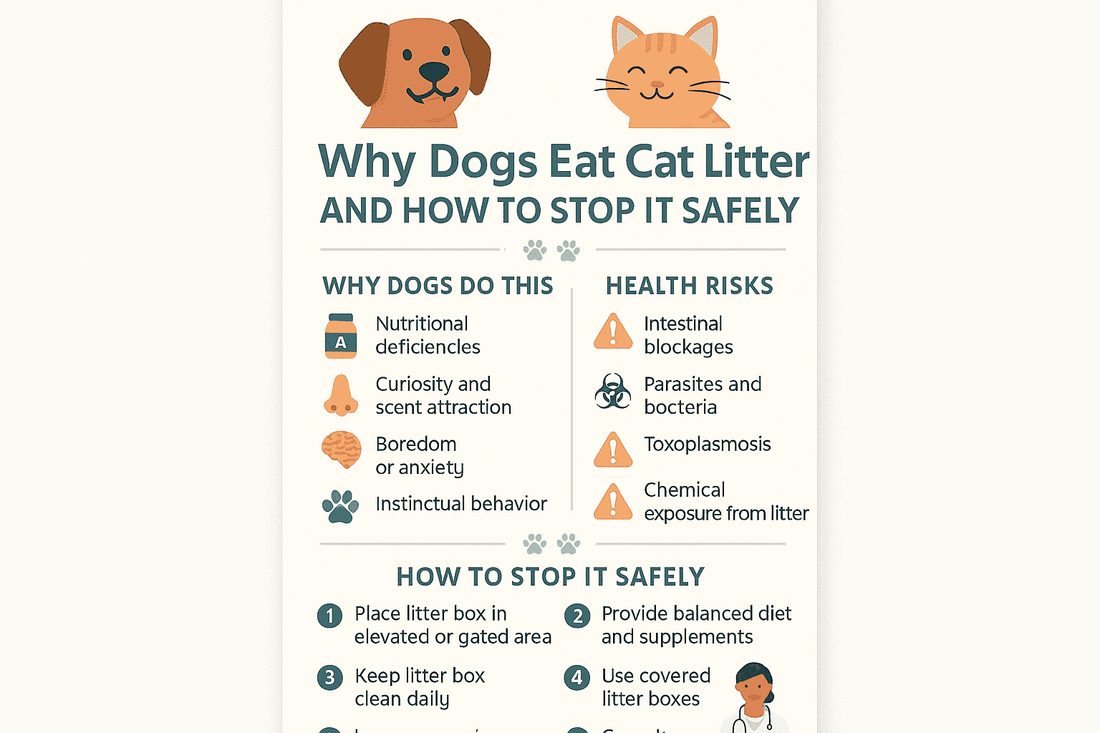
Dogs Eating Cat Litter: Why It Happens and How to Stop It
Share
Q: Why is my dog eating cat litter or cat poop?
A: Most often it’s curiosity, habit, or boredom — but sometimes medical issues like poor nutrition or parasites are at play. With simple environment, feeding and training changes you can usually stop the behavior.
Sharing a home with cats and dogs brings many perks, and a few challenges—one very common frustration is dogs eating cat litter or cat feces. The behavior (called coprophagia when it involves feces) is unpleasant, but understanding causes, risks, and practical solutions helps protect both pets and people.
What causes dogs to eat cat litter and poop?

Veterinary sources list several overlapping causes:
Behavioral drivers
- Exploration and scavenging: Dogs use their mouths to investigate; cat feces often smells strongly of protein. (See the American Kennel Club’s guidance on coprophagia.) AKC: Why Dogs Eat Poop.
- Habit or boredom: If a dog discovers the litter box tastes rewarding, the habit can quickly repeat. More exercise and enrichment often help. PetMD on Coprophagia.
- Stress or hiding accidents: Dogs punished after house-soiling may eat feces to hide evidence, which reinforces the behavior.
Medical and nutritional causes
Vets note that some dogs eat stool because of:
- Poor nutrient absorption or malnutrition;
- Intestinal parasites or endocrine conditions (e.g., Cushing’s) that increase appetite;
- Age-related cognitive decline in older dogs leading to odd behaviors. See the VCA Hospitals overview on coprophagia for details.
Health risks when dogs eat cat litter or feces
Eating cat feces and litter carries risks to both your dog and people in the home:
| Risk | Why it matters |
|---|---|
| Parasites & zoonotic germs | Cat feces can contain parasites such as Toxoplasma gondii and bacteria like Salmonella. The CDC explains how Toxoplasma spreads and how to reduce risk. CDC: Toxoplasmosis. |
| Gastrointestinal upset | Vomiting, diarrhea, or appetite loss can follow ingestion of contaminated feces or litter. |
| Blockage risk | Clumping litter swallowed in quantity may form a mass and obstruct the digestive tract — a veterinary emergency. |
Practical, vet-backed strategies to stop the behavior
Use a layered approach: environment changes + training + health checks.
1. Litter-box placement and design
- Put boxes where cats can enter but dogs cannot—use a cat door, small pet-door, or a baby gate with a cat pass-through.
- Try elevated or top-entry boxes that are easy for cats but hard for most dogs to reach.
- Consider fully enclosed boxes or dog-proof housings while keeping your cat comfortable.
2. Scoop immediately and keep boxes clean
Scooping at least once daily — ideally right after your cat uses the box — removes the “reward” for litter-box raiding. Frequent cleaning also reduces odor and bacterial growth.
3. Training and enrichment
- Teach a reliable leave it or out cue and reward calm, non-reactive behavior near the litter area.
- Provide interactive toys, puzzle feeders and extra walks to reduce boredom.
- Avoid punishment—this may increase anxiety and worsen the habit. See PetMD’s behavior recommendations for step-by-step guidance. PetMD on stopping poop eating.
4. Nutrition and vet checkups
Confirm your dog’s diet meets AAFCO guidelines and is age-appropriate. If coprophagia appears suddenly or your dog shows other signs (weight loss, vomiting, increased appetite), schedule a veterinary exam and fecal tests for parasites. The VCA Hospitals resource covers medical causes and diagnostics.
5. Targeted deterrents and products
- Some veterinary additives (wheat-gluten + MSG combinations) are prescribed to make stools less appealing—discuss options with your vet.
- Dog-proof litter enclosures, or products designed for multi-pet homes, can help. Trusted vendors like Famistar offer litter-box systems intended for households with both dogs and cats (ensure any product maintains the cat’s privacy and comfort).
Quick checklist: stop dogs from eating cat litter
- Scoop litter immediately after the cat uses it.
- Move the box to a dog-inaccessible spot (or use a top-entry box).
- Give your dog more exercise and puzzle toys.
- Teach a strong leave it cue and reward success.
- Have your vet rule out parasites, malabsorption, or other medical issues.
FAQ — common long-tail questions
Will my dog get toxoplasmosis from eating cat poop?
While cats can shed Toxoplasma in feces, the parasite’s eggs (oocysts) need time in the environment to become infectious. Proper litter handling and hygiene significantly reduce risk. See CDC guidance on toxoplasmosis prevention. CDC: Toxoplasmosis.
Is non-clumping litter safer if my dog eats litter?
Non-clumping litter lowers the risk of an intestinal mass, but it doesn’t stop the behavior. Focus on access control, training, and veterinary checks as primary solutions.
Can I re-home the cat litter box outdoors?
Outdoor boxes can reduce dog access but may be unsuitable in cold or unsafe climates, and they can increase exposure to parasites. Indoor control is usually a better first step.
When to call your veterinarian
Contact your vet if your dog shows vomiting, persistent diarrhea, lethargy, or if the litter-box raids begin suddenly—especially in older dogs. A vet can run fecal tests, bloodwork, and discuss behavior or dietary solutions. Trusted veterinary resources like VCA Hospitals and PetMD cover both behavioral and medical diagnostics.
Final thoughts (and a small, practical tip)
Dogs eating cat litter is a common — and solvable — household problem. The fastest wins come from making the litter box inaccessible, cleaning it promptly, giving your dog plenty of enrichment, and checking with your vet when the behavior persists.
If you’re looking for litter boxes and housings designed for multi-pet homes, consider options that protect your cat’s privacy while keeping dogs out—brands such as Famistar design solutions that focus on functionality for multi-pet households. Always prioritize your cat’s comfort and consult your veterinarian for any medical concerns.
Need a All-In-One Smart Self-Cleaning Cat Litter Box? Click to View Details

